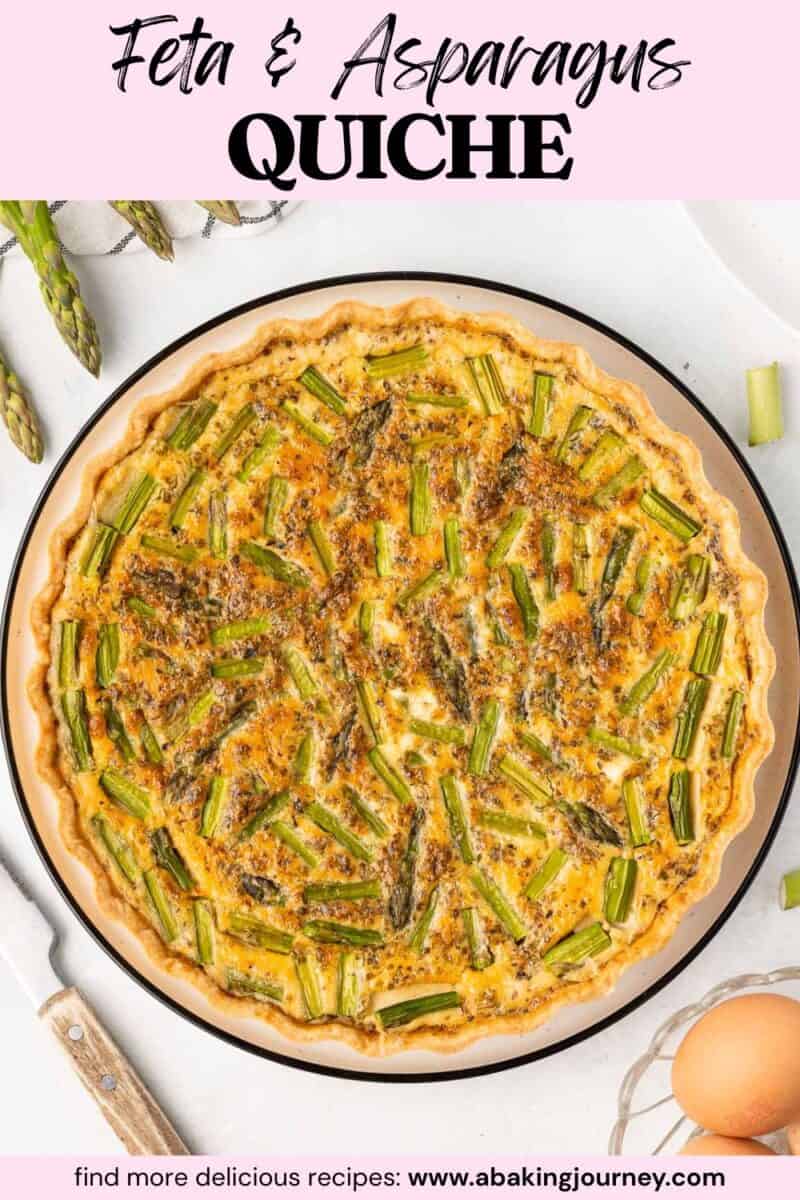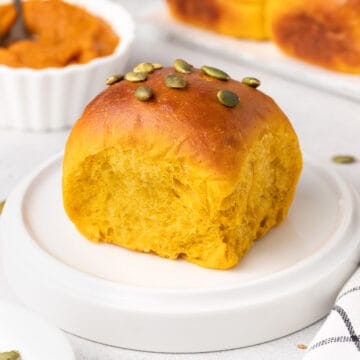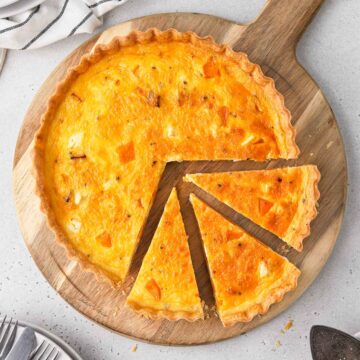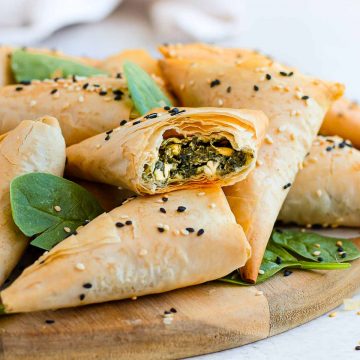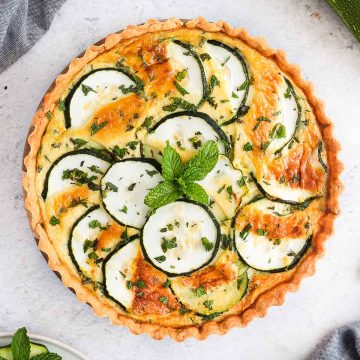This Feta and Asparagus Quiche is a great dish for breakfast, brunch, lunch, or even a light dinner. The deliciously buttery and flaky homemade crust is filled with a fluffy custard mixture packed with feta cheese and tender asparagus.
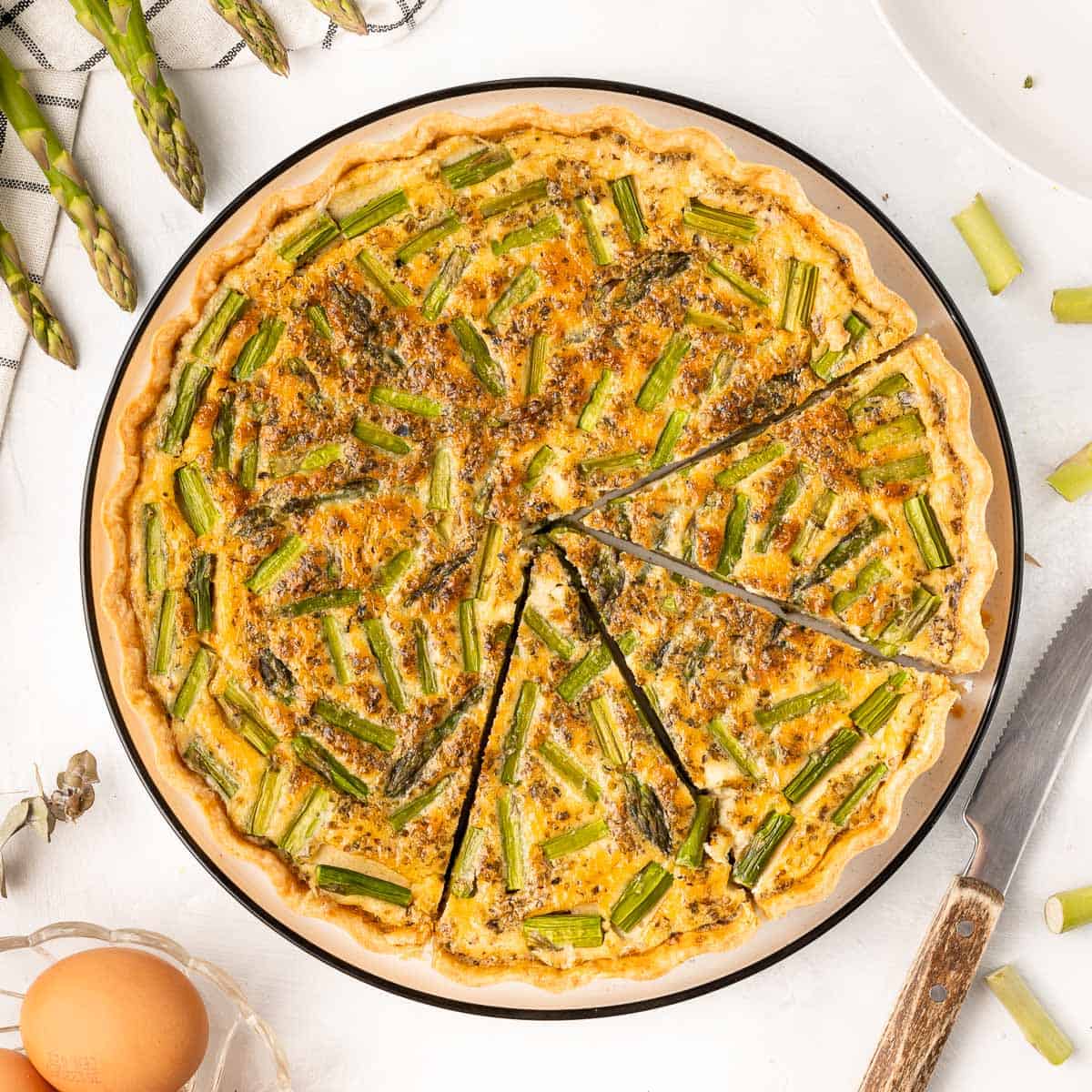
This recipe was first published in November 2018 and updated in January 2023.
Jump to:
Why we love this recipe
This easy Feta and Asparagus Quiche recipe makes a delicious vegetarian dish that is perfect to serve for breakfast and brunch, lunch or even dinner. It combines a flaky quiche pastry with a fluffy egg custard filling packed with tender asparagus chunks and cubes of feta cheese.
This quiche can be made ahead of time, making it a great option for hosting a brunch and lunch or for meal prepping during the week. It also freezes really well!
More Quiches with Feta:
Ingredients
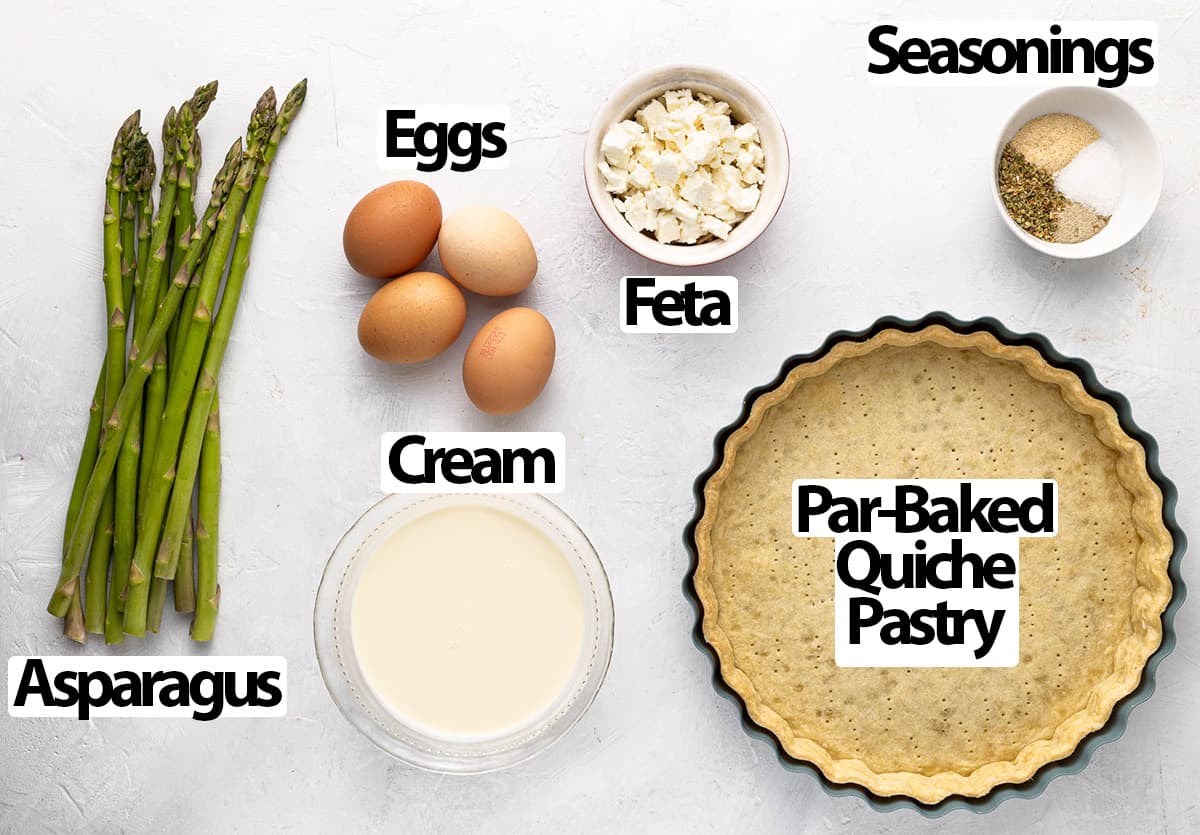
Scroll down to recipe card below for all quantities
This easy asparagus quiche is made of:
For the savoury shortcrust pastry:
- Flour + Salt: Plain / All-Purpose Flour and Fine Table Salt. You can also add any seasoning or spices you'd like to the dry ingredients.
- Butter: Unsalted Butter, very cold and cut into small cubes.
- Water: very cold. The exact quantity of water can vary based on the brand of flour you use, so add it little by little.
For the feta and asparagus filling:
- Custard Base: a classic mix of Thickened / Heavy Cream (double cream in the UK) and Eggs. I used large eggs here, at room temperature. I don't recommend using light cream and you need the extra fat for flavour and texture.
- Seasoning: a mix of Salt, White Pepper, Garlic Powder and dried Oregano. You could use any additional spices you'd like as well!
- Asparagus: I used green asparagus, but you could try with white asparagus as well. Remove the bottom of the asparagus spears that tend to be hard. Cut the rest of the stem into small chunks that are about 1 cm long.
- Cheese: Feta Cheese, cut into small cubes. I used Greek feta.
Flavour Variation
This quiche is a versatile recipe that can be customised with the addition of more vegetables, some meat or a different kind of cheese.
- Use a different Cheese: you can use crumbed Goat Cheese as a substitute to the feta cheese. You can also choose some grated cheese such as parmesan, cheddar or gruyere cheese if preferred.
- Add more Veggies: mushrooms, onions, spinach, leeks,...
- Add some Meat: bacon, pieces of cooked chicken,... or even some fish with smoked salmon.
How to make Asparagus Quiche
Making the Quiche Pastry
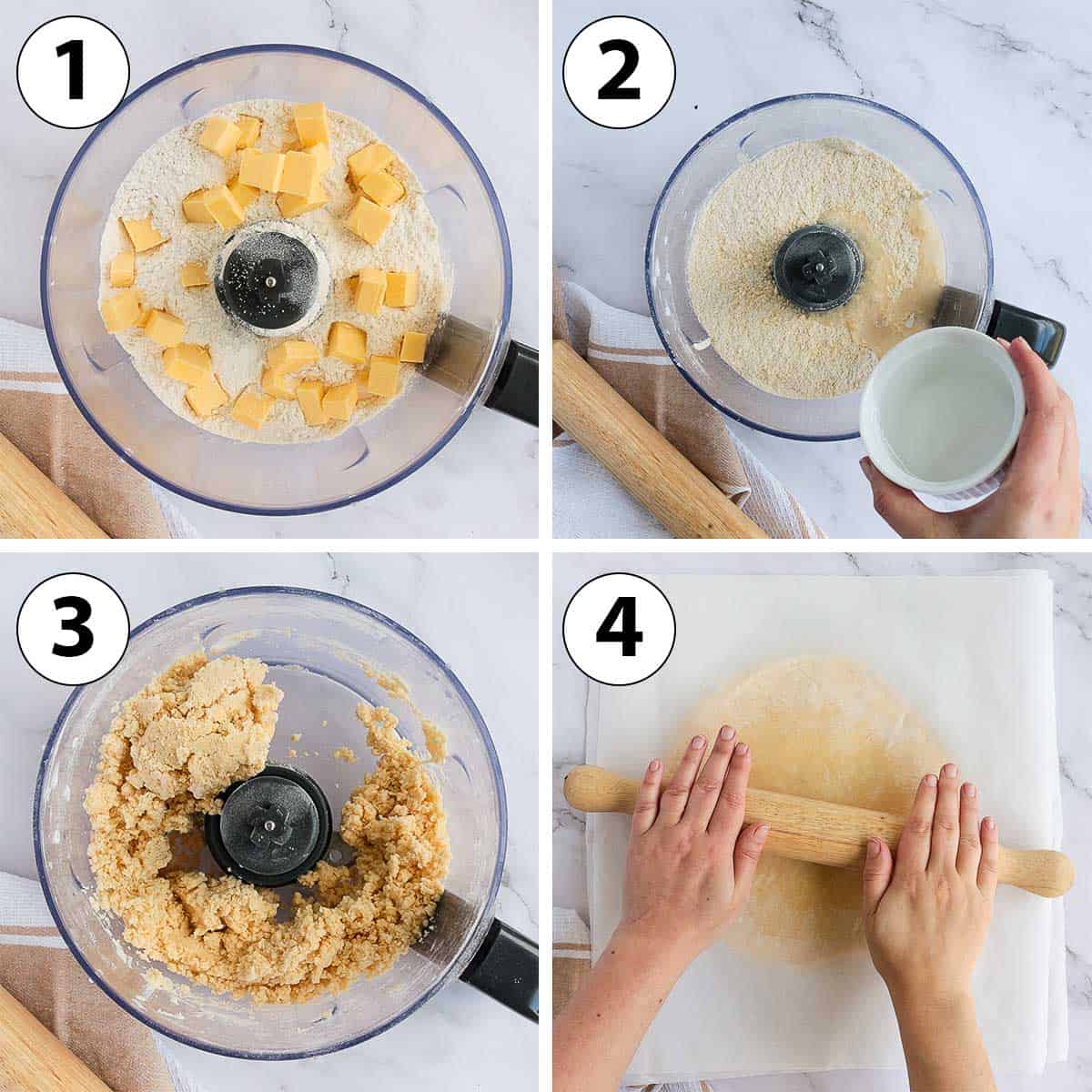
The pie crust is simply made in a food processor. It can also be made by hands if preferred; check out my Savoury Shortcrust Pastry recipe for detailed instructions.
You can use store bought pie crust if preferred, but they tend to come already sweetened which is not ideal for a quiche.
- Photo 1: Place the Flour and Salt in the bowl of your food processor and pulse to mix. Add the very cold cubed Butter.
- Photo 2: Blend for about 30 seconds, or until you get very small crumbs of butter that are evenly distributed in the dry ingredients.
- Photo 3: Slowly add the Water while the food processor is running.
- Photo 4: Keep on mixing until a rough dough starts to come together.
The exact quantity of water might vary based on the brand of flour you use. Start by adding a little bit of water while mixing and add more than the recommended quantity to reach the desired consistency.
To know the dough is right, press together some of the crumbs. If they stick together and combine into a smooth dough, it is ready. If still dry and crumbly, add a little bit more water.
Lining the quiche pan & par-baking the crust
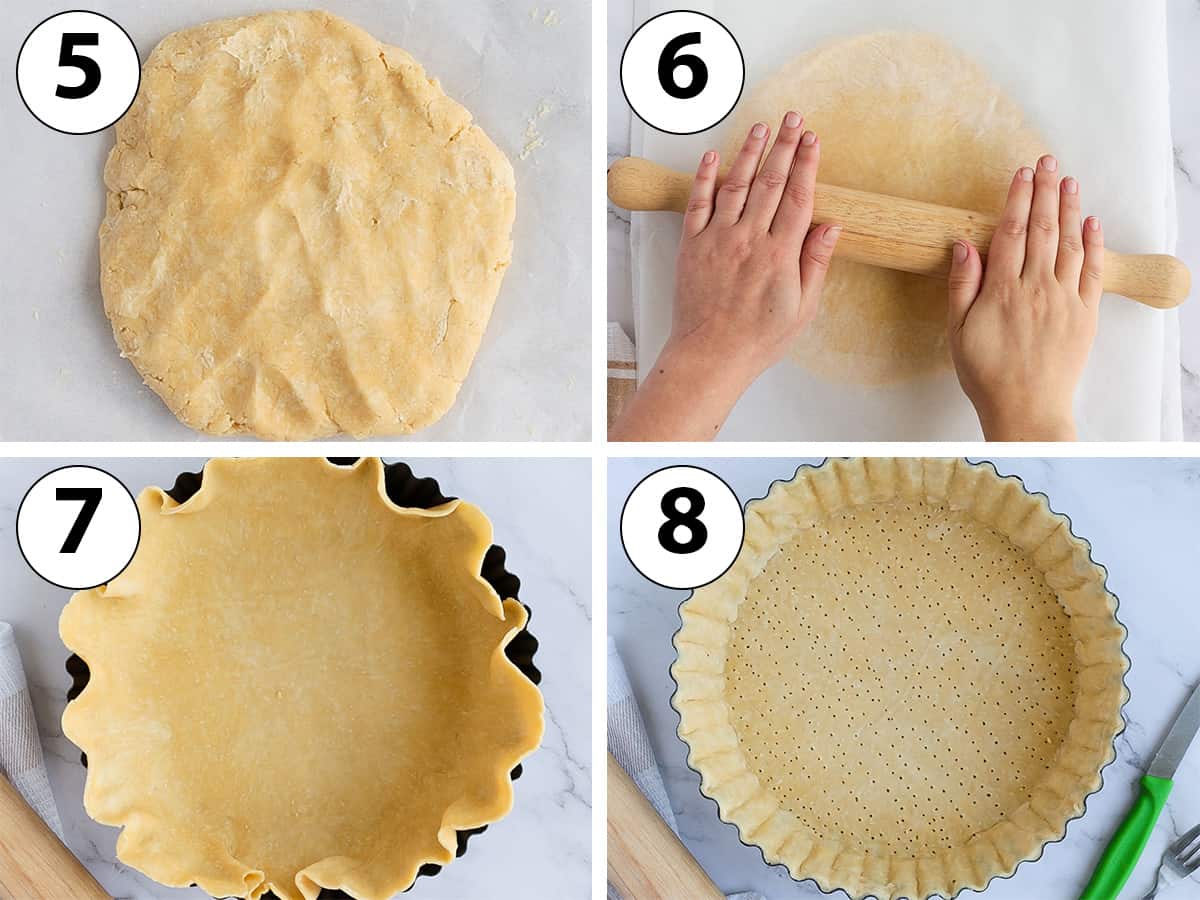
- Photo 5: Place the rolled pie dough over a large sheet of baking paper, bring it together into a ball and slightly flatten it.
- Photo 6: Cover with a second sheet of baking paper / parchment paper and roll into a large disk that is about 4mm thick (1/6 inch). Place over a flat tray and put in the fridge to chill and rest for at least 1 hour, or overnight.
- Photo 7: Leave at room temperature for about 5 minutes so that the pastry can very slightly soften, then remove the baking paper and place inside a 25 cm (10-inch) quiche pan that is about 4 cm tall (1,5-inch).
You can also use a metal pie pan or deep dish, but it will be easier to use a pan with removable bottom plate like the one I used here.
- Photo 8: Gently slide the pastry down the sides of the pan. Press on the bottom corners and the sides of the pan to make sure the pastry is completely flush with the pan. Use a sharp knife to cut out any excess dough.
- Place in the refrigerator to chill for at least 2 hour, preferably overnight. The more you rest it, the less it will shrink or move in the oven.
- Preheat your oven on 160 degree Celsius (325 degree Fahrenheit) and place the crust in the freezer in the meantime. Dock the bottom of the pastry (make small holes with a fork), cover with baking paper and fill with baking weights (pie weights, rice or dry beans).
- Par-bake for 15 minutes. Remove the weights and baking paper and bake for an additional 10 to 15 minutes. Set aside to cool down.
Making the Asparagus Filling
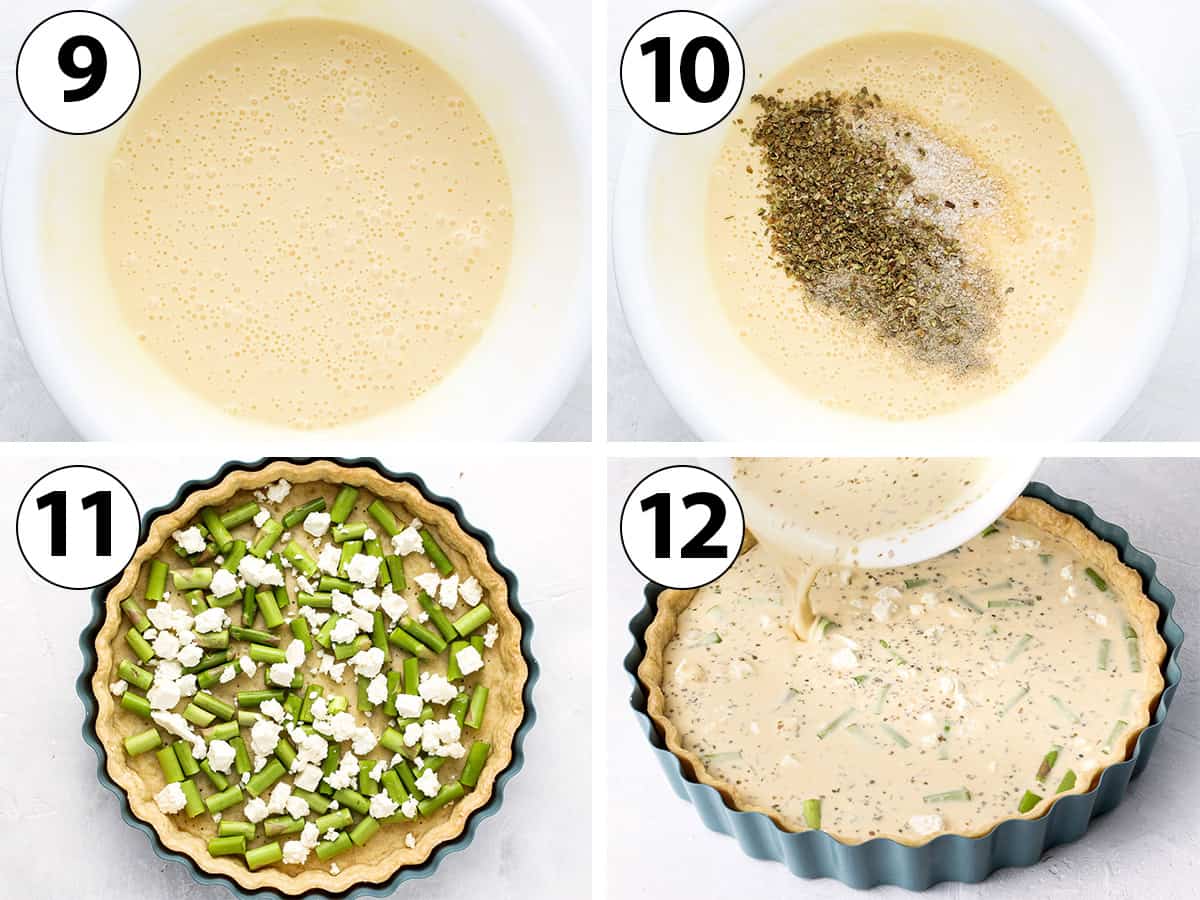
- Wash the asparagus and snap off the bottom of the spears. Slice each stem into small chunks that are about 1 cm long (0,4-inch). Cut the feta into small cubes or crumbs. Set aside.
- Photo 9: In a large bowl, whisk together eggs and cream until smooth.
- Photo 10: Whisk in the salt, pepper, garlic powder and dried oregano.
- Photo 11: Place the asparagus pieces at the bottom of the par-baked quiche crust and top with the crumbed feta. Optionally, keep a little bit of asparagus and cheese to sprinkle of the custard.
- Photo 12: Pour the egg mixture over the raw asparagus and feta. Optionally top with the rest of the veggies and cheese.
- Bake for 35 to 40 minutes or until the egg filling looks lightly golden and the filling is fully baked and set.
- Take out of the oven and leave to cool down for 10 to 15 minutes before serving.
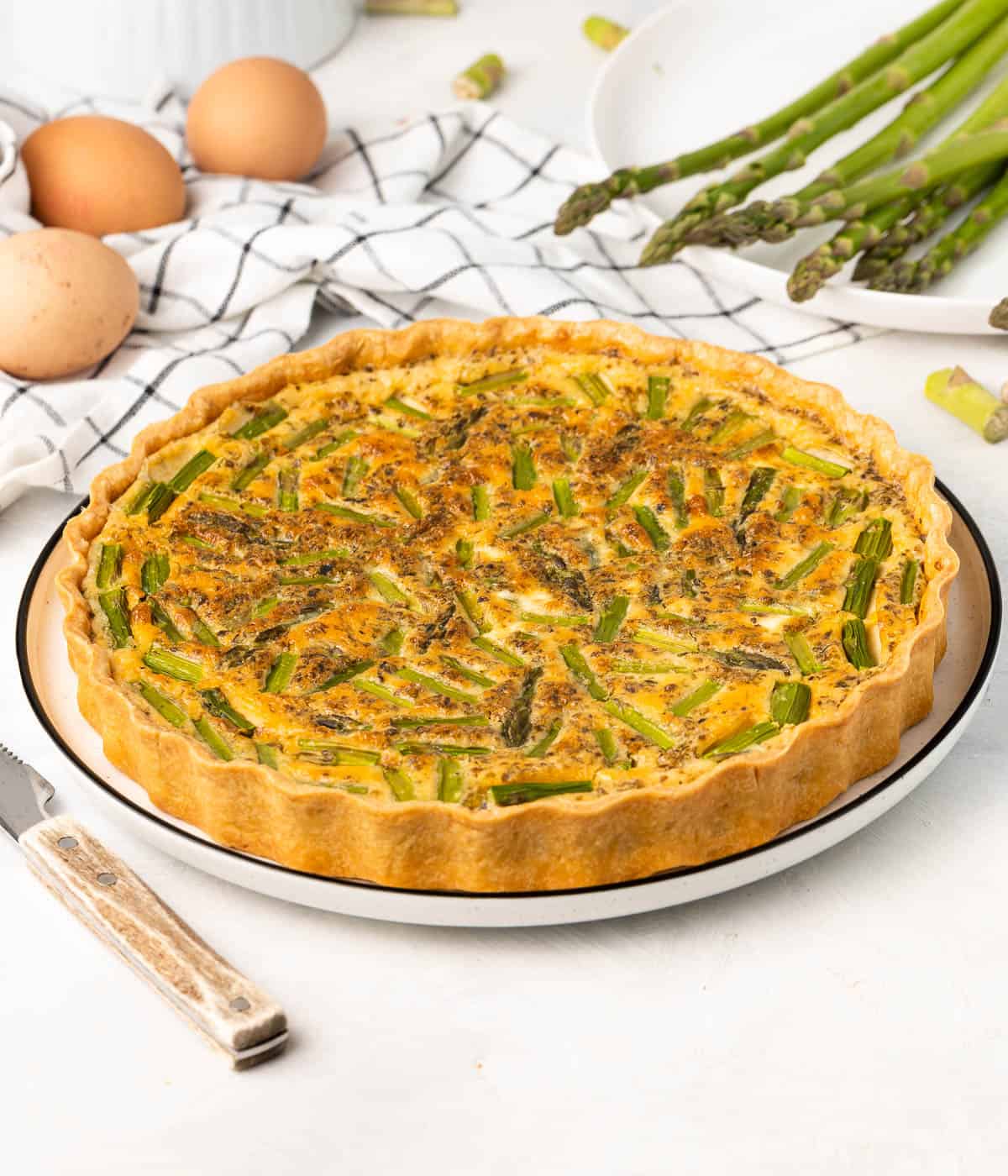
Recipe FAQs
There are a few differences between Quiches and Frittata (other than the fact that one is French and the other Italian):
- Quiches usually have a crust made out of Pastry while Frittata don't.
- Quiches are baked in tart pan in the oven, Frittata are usually made directly in a frying pan on the stove.
- The filling for a quiche combines eggs and cream, while a frittata is usually only made with eggs.
You can use a simple Tart Pan to make a Quiche, but I recommend using a proper Quiche Pan with removable bottom.
What is the difference? I Quiche Pan will have higher edges than a Tart Pan, so you can have a nice, thick custard filling. If you use a tart pan, you will end up with something that looks more like a savoury tart than a quiche.
I didn't cook the asparagus first as the baking time of the quiche should be enough to fully cook the small chunks of vegetables. If you preferred to have very soft and tender asparagus, you can first cook them in a large skillet with a little bit of olive oil over medium heat.
This asparagus quiche will be great on its own for breakfast or brunch, or serve with a simple green salad or roasted veggies for dinner.
You can also top each slice with a dollop of Crème Fraiche (light sour cream).
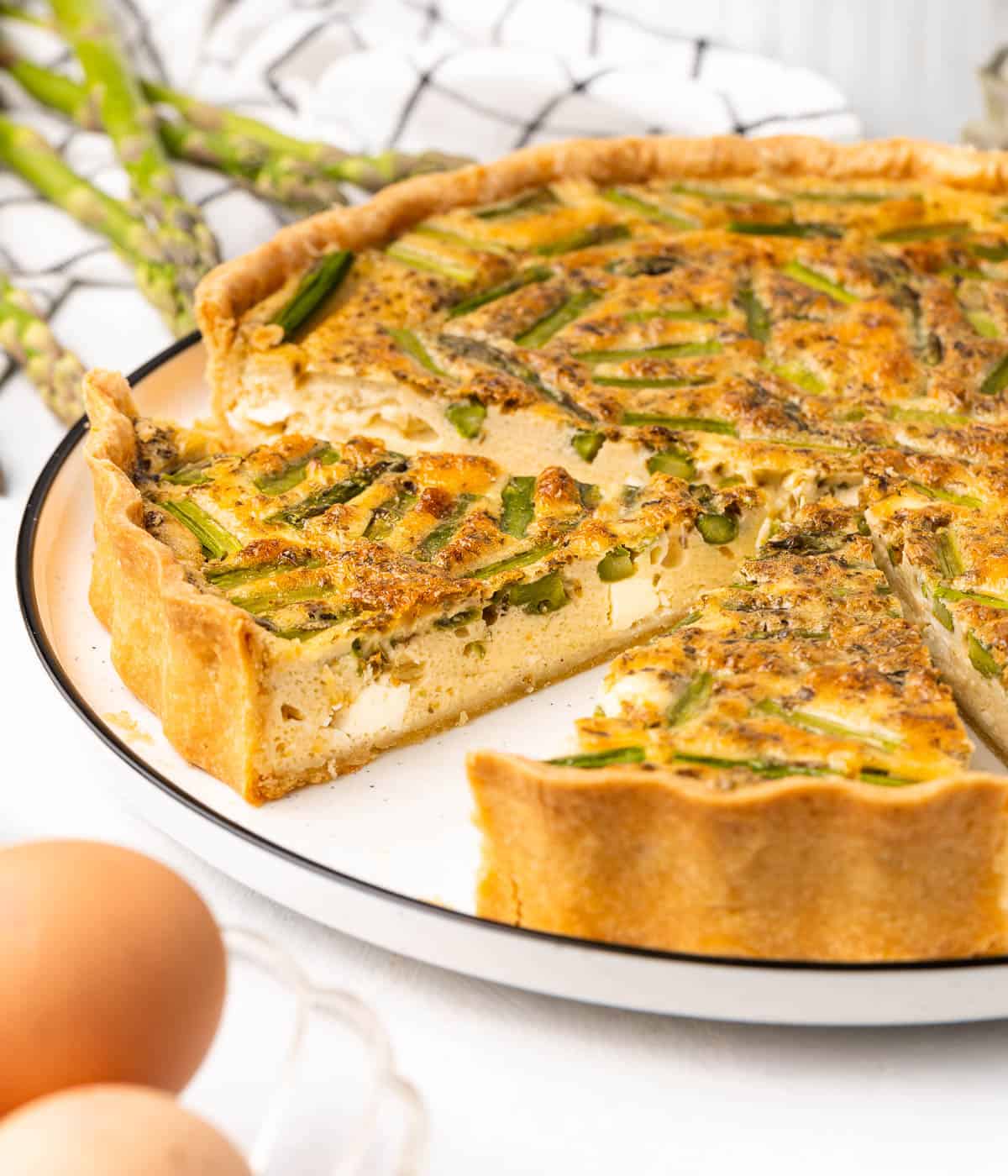
Tips & Troubleshooting
- The secret to making a good quiche is par-baking the crust perfectly so that it is deliciously flaky, and cooking the quiche for the right time to achieve a light and fluffy but fully set filling.
- How to keep the bottom crust of a quiche from getting soggy: make sure to par-bake the pastry before adding the filling. I bake it first with weights then without to make sure the bottom of the quiche stays is as dry as possible.
- How do you keep ingredients from sinking in a quiche: because we are cutting the asparagus into small chunks, they should be light enough to float inside the egg custard filling. If you prefer to keep the asparagus whole, you could toss them in a little bit of flour to make sure they don't sink.
- How to know a quiche is done baking: gently (and carefully) shake the quiche pan back and forth. If the centre of the quiche still jiggles, it is not ready. If there is no (or not much) movement in the filling, it's ready. If the filling browns too quickly, cover it with aluminum foil.
Storing & Freezing
- Storing: the asparagus quiche will last for up to 3 days in the fridge covered with plastic wrap, but is best served within 24 hours. Leftovers should be stored in the fridge in an airtight container or cover with foil or wrap.
- Make ahead: slightly underbake the quiche and finish cooking it just before serving. If the top is browning before the quiche is fully reheated, cover with aluminium foil.
- Reheating: the whole quiche can be reheated in the oven (cover with foil if required). Individual slices can be reheated either in the oven or in the microwave, but the pastry will get more soggy in the microwave.
- Freezing: you can freeze the asparagus quiche either unbaked or baked, whole or pre-cut into individual slices. Allow to thaw in the fridge for a few hours before cooking / reheating in the oven.
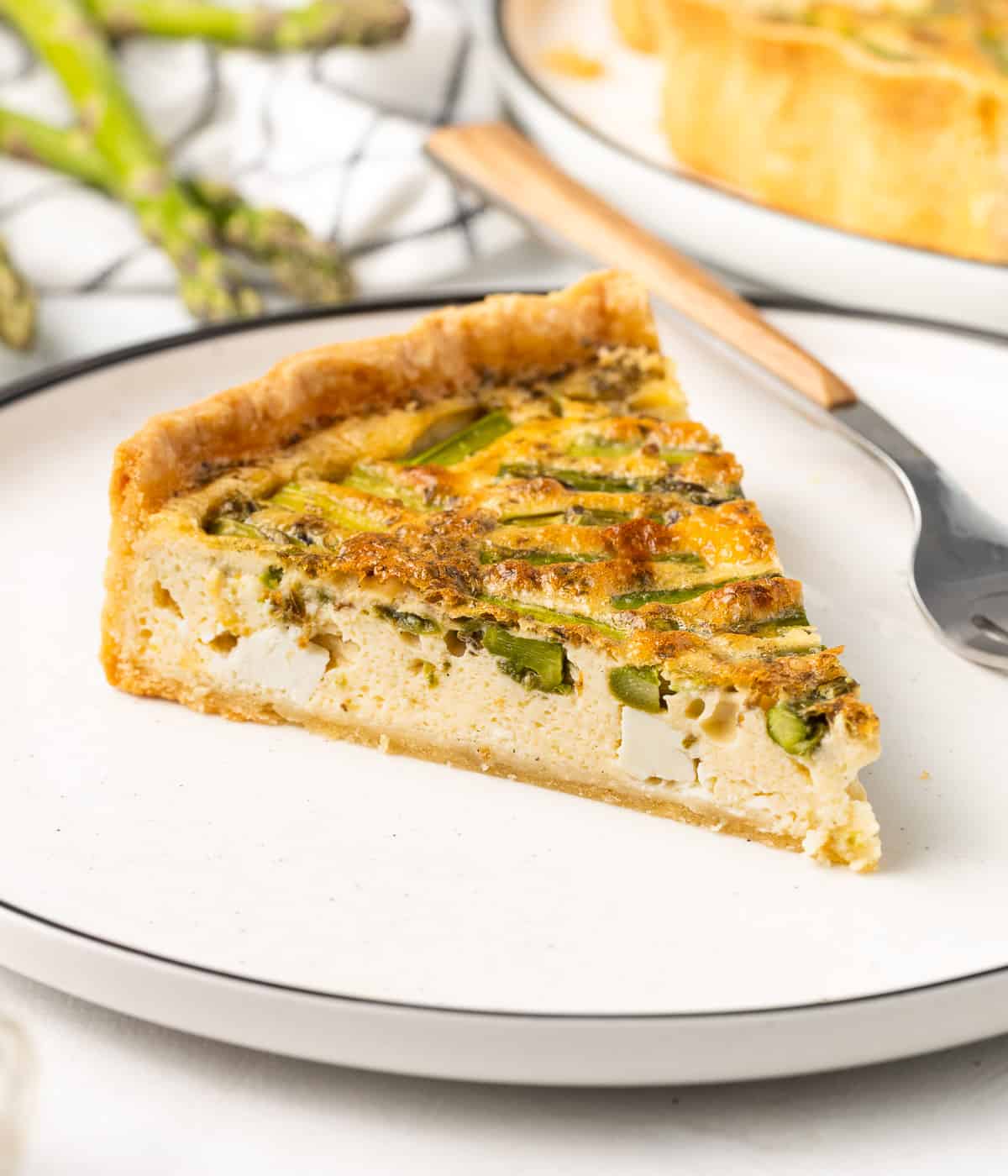
Made this recipe?
Let us know if you liked it by leaving a comment below, and tag us on Instagram @a.baking.journey with a photo of your creation!
Recipe
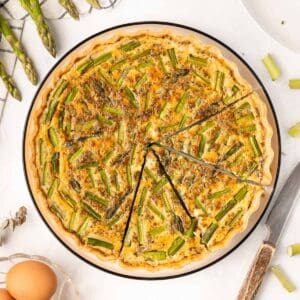
Feta and Asparagus Quiche
Ingredients
Quiche Pastry
- 200 gr (1 1/3 cup) Plain / All-Purpose Flour
- 1/2 teaspoon Fine Table Salt
- 100 gr (6 1/2 tablespoons) Unsalted Butter - very cold
- 65 ml (1/4 cup + 1 teaspoon) Water - very cold
Asparagus Quiche Filling
- 1 dozen Asparagus
- 100 gr (3,5 oz) Feta Cheese - crumbed
- 300 ml (1 1/4 cup) Heavy / Thickened Cream
- 4 large Eggs
- 1 teaspoon Fine Table Salt
- 1/3 teaspoon White Pepper
- 1 teaspoon Garlic Powder
- 1 teaspoon Dried Oregano
Disclaimer
I highly recommend using the measurements in grams & ml (instead of cups & spoons) for more accuracy and better results.
Instructions
Quiche Pastry
- Place the Flour and Salt in the bowl of your food processor and pulse to combine (see note 1 to make the pastry by hands). Add the cold cubed Butter and pulse for about 30 seconds or until the butter is turned into very small crumbs.
- While the food processor is on, slowly add the very cold Water. Continue to mix until a rough dough starts to come together (see note 2).
- Transfer the pastry over a large sheet of baking paper and bring it together into a ball. Cover with a second sheet of baking paper, slightly flatten the dough with your hands then roll into a large disk that is approximatively 4 mm thick (1/6 inch). Place in the fridge to chill for at least 1 hour.
- Leave at room temperature for 5 minutes, then remove the baking paper and place inside a 25cm wide, 4 cm deep (10-inch x 1,5 inch) Quiche Pan. Slide the pastry down the sides of the pie dish and gently press on the bottom corners and the sides of the pan to make sure the pastry is completely flush with the pan.
- Place back in the fridge to rest and chill for at least 1 hour, preferably overnight.
- Preheat your oven on 160 degree Celsius (325 degree Fahrenheit). While the oven is preheating, put the pastry in the freezer. Take out of the freezer, dock the bottom of the pastry (make small holes with a fork) and cover with baking paper and baking weights.
- Par-bake for 15 minutes. Remove the weights and baking paper and bake for an additional 10 to 15 minutes. Set aside to cool down.
Quiche Filling
- Wash the asparagus and snap off the bottom of the spears. Slice each stem into small chunks that are about 1 cm long (0,4-inch). Cut the feta into small cubes or crumbs. Set aside.
- In a large bowl, whisk together the eggs and cream. Add the salt, pepper, garlic powder and oregano and whisk until combined.
- Place the asparagus pieces at the bottom of the par-baked quiche crust and top with the crumbed feta (see note 3). Pour the egg mixture over the asparagus and feta.
- Bake for 35 to 40 minutes or until the egg filling looks lightly golden and the filling is fully baked and set (see note 4). Take out of the oven and leave to cool down for 10 to 15 minutes before serving.
Tried this recipe? Make sure to leave a comment and star rating below!
Notes
- You can make the pastry with your hands (or using a Pastry Blender). Place the Flour and Salt in a Large bowl and add the Butter cut into very small cubes. Rub the Butter with the Flour using your fingers and palms until all the butter has been incorporated into the flour. Add the Water and work the dough with you fingers to bring it together.
- You might need a little bit less or a little more water here - the quantity can vary wth the specific brand of flour you use. To know the pastry is right, press some of the dough inside your hand. If the crumbs stick together and turn into a smooth dough, it is ready. If still dry and crumbly, add a little bit more water.
- Optionally, keep a few chunks of asparagus and cheese to top over the filling before baking.
- To know the quiche is done baking, gently (and carefully) shake the quiche pan back and forth. If the centre of the quiche still jiggles, it is not ready. If there is no (or not much) movement in the filling, it's ready. If the filling browns too quickly, cover it with aluminum foil and finish baking.

